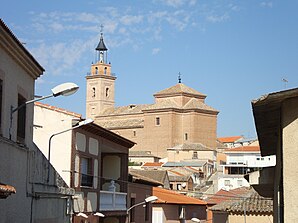Cebolla (Toledo)
| Cebolla municipality | ||
|---|---|---|
 Cebolla - View of the town with the Church of San Cipriano
|
||
| coat of arms | Map of Spain | |

|
|
|
| Basic data | ||
| Autonomous Community : | Castile-La Mancha | |
| Province : | Toledo | |
| Comarca : | Torrijos | |
| Coordinates | 39 ° 57 ′ N , 4 ° 34 ′ W | |
| Height : | 440 msnm | |
| Area : | 36.77 km² | |
| Residents : | 3,235 (Jan 1, 2019) | |
| Population density : | 87.98 inhabitants / km² | |
| Postal code : | 45680 | |
| Municipality number ( INE ): | 45046 | |
| administration | ||
| Website : | Cebolla | |
Cebolla is a small town and one of the main village and the hamlets (Pedanías) La Aldehuela , Villalba , Sanchón and Las Casas de Cebolla existing central Spanish municipality ( municipio ) with a total of 3,235 inhabitants (at January 1, 2019) in the province of Toledo in the Autonomous Community of Castile-La Mancha .
Location and climate
The small town of Cebolla is located approx. 2 km north of the Tagus, almost 55 km (driving distance) northwest of Toledo in the historical province of La Mancha at an altitude of approx. 440 m ; to Madrid it is a good 100 km in a north-easterly direction. The climate in winter is harsh, but in summer it is dry and warm; the sparse rain (approx. 365 mm / year) falls mainly in the winter months.
Population development
| year | 1857 | 1900 | 1950 | 2000 | 2017 |
| Residents | 2.016 | 2,343 | 3.165 | 2,809 | 3,344 |
After a significant population decline as a result of the mechanization of agriculture and the abandonment of small farms in the second half of the 20th century, the small town has benefited from the comparatively low property prices in the country and the good transport links to the greater Madrid area since the beginning of the 21st century.
economy
The area around Cebolla was and is essentially agricultural, with viticulture and olive tree plantations playing important roles; the small town itself served as a craft and mercantile center for the surrounding villages.
history
The foundation walls of a country estate ( villa rustica ) date from Roman times , which was also used in Visigothic times and has been known as Los Merillos for centuries . In the 8th century the Arab-Moorish armies penetrated far to the north of the Iberian Peninsula . In the years 1083-1085 the area was occupied by Alfonso VI. recaptured ( reconquista ) , but shortly afterwards threatened again by the Berber Almoravids under Ali ibn Yusuf ibn Tashfin . It was not until Alfonso VII (reigned 1126–1157) that the La Mancha region finally became Christian around 1130. The place was first mentioned in a document in 1184. In 1205 the area was placed under the order of the Calatrava ; later it also briefly belonged to the Knights Templar . Already in 1477 the place received city rights (villa) .
Attractions
- The three-aisled Iglesia de San Cipriano , built almost entirely of bricks, is dedicated to St. Consecrated to Cyprian of Carthage ; it dates from the first half of the 17th century and rises on the site of an older church from which the baptismal font has been preserved. The tower is considered the work of the Augustinian architect Lorenzo de San Nicolás (1595–1679), who was involved in numerous church buildings in the region. The interior of the church is - apart from several baroque carved altars - designed in the classical style of the 18th century.
- On the outskirts of the village rises a court column (roller blind) composed of several drums with a capital jutting out in all directions on a round stepped base .
- The Palacio de los Duques de Frías is a rather unadorned building made entirely of bricks from the 17th century.
- Surroundings
- The Castillo de Villalba rises on a hill about 3 km southeast of the place ( 39 ° 54 '43.6 " N , 4 ° 32' 15.3" W ). It dominates the valley of the Tagus and was probably built by the Moors , later rebuilt by the Templars and finally passed into the possession of the Dukes of Frías .
- Approx. 3 km outside the town is the Ermita de San Illán , which is dedicated to the late son of Isidore of Madrid and his wife María de la Cabeza .
Web links
- Cebolla, sights - photos + information (Spanish)
Individual evidence
- ↑ Cifras oficiales de población resultantes de la revisión del Padrón municipal a 1 de enero . Population statistics from the Instituto Nacional de Estadística (population update).
- ↑ Cebolla - climate tables
- ↑ Cebolla - population development
- ↑ Cebolla History
- ↑ Order affiliation and life dates according to Thierry Nebois (coordination of the edition): Architectural Theory. From the Renaissance to the Present . Taschen, Cologne 2003, p. 378.
- ↑ Cebolla Church
- ↑ Cebolla - court column
- ↑ Cebolla - Palacio
- ^ Cebolla - Castillo
- ^ Cebolla - Castillo
- ↑ Cebolla - Ermita de San Illán

